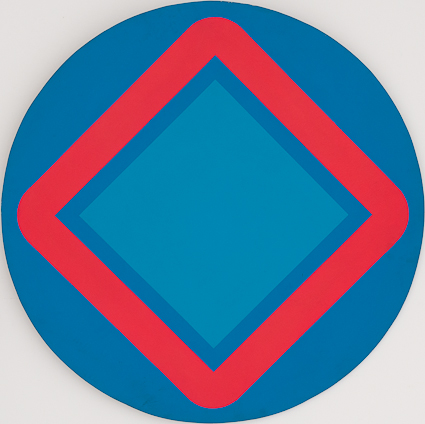Winfred Gaul
Diamond Blues III, 1967/69
Acrylic on canvas, mounted on chipboard
Ø 100 cm
© VG Bild-Kunst, Bonn 2022
Photo: Galerie Schlichtenmaier
Winfred Gaul was one of the foremost practitioners of non-representational painting in post-war Germany. In the mid-fifties he presented himself to the world at large with art informel works, and achieved his international break-through in 1959 at the documenta. But during this period he had already turned from the subjective imagery of art informel and devoted himself to a systematic examination of the possibilities of rational expression offered by the medium of painting. His endeavours to gain clarity about the visual means can be seen in his series Verkehrszeichen und Signale [Traffic Signs and Signals], which he commenced in 1961 under the impressions he gathered during a trip to the USA and from everyday life on the streets of Rome, where he lived at the time. Fascinated by the posters, billboards and signals, those urban insignia of the streams of traffic and commodities during the years of the “economic miracle”, Gaul picked up on the striking structures in their colours and forms. But he did not simply imitate urban imagery, he removed it from its original context and transposed it by his art into a new reality. The works he was now producing distinguished themselves by their dazzling colours and exactly delineated, precisely painted geometrical shapes. As a result of their triangular, hexagonal, circular and diamond shaped formats, these paintings are regarded as early examples of “shaped canvases”. Done at the beginning of the sixties, the works also contained citations from advertising and media culture, but these disappeared mid-decade as Gaul increasingly turned his attention to his Verkehrszeichen.
Already the title Diamond Blues III names the key elements of the painting: the diamond shape and the two shades of blue. The circular canvas with its blue ground shows a square done in a paler blue that has been set on one corner and enclosed in a red frame. While a blue disc is associated with a mandatory road sign, the red diamond suggests a right of way sign. Gaul defamiliarises the sign language we are accustomed to by manipulating the colours, heightening their impact through new contrasts, and by allowing the red shape to stand out visually. With that, inner and outer form, content and colouration enter a charged relationship that subverts the code employed in real traffic signs. Diamond Blues III emphasises its symbolic character through the stereotypically reduced, geometrical grammar of forms and the brash use of blazing colours. Unhampered by any message bound to conventions, the painting is part of a new visual system freely invented by the artist, and is not intended to convey any meaning. (Camilla Bonath-Völkel)
Winfred Gaul
1928 born in Kalkum (Dusseldorf)
2003 died in Dusseldorf


